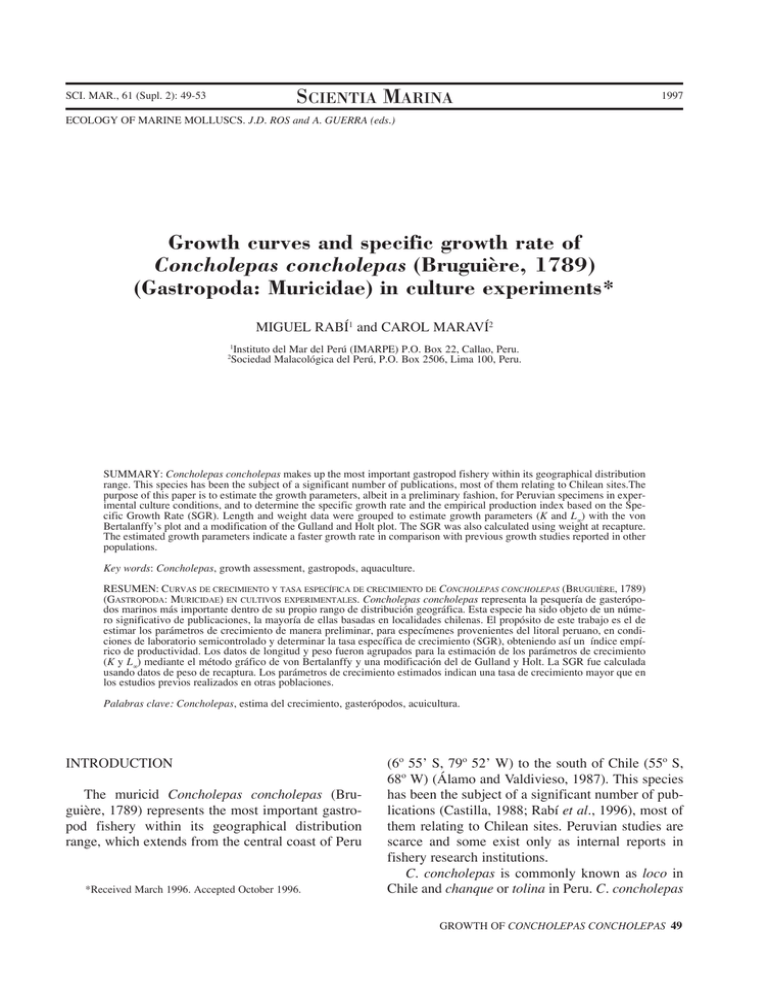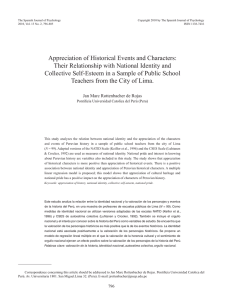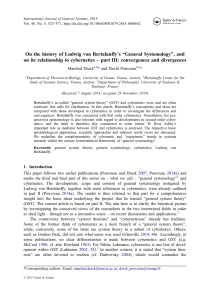Growth curves and specific growth rate of Concholepas
Anuncio

SCIENTIA MARINA
SCI. MAR., 61 (Supl. 2): 49-53
1997
ECOLOGY OF MARINE MOLLUSCS. J.D. ROS and A. GUERRA (eds.)
Growth curves and specific growth rate of
Concholepas concholepas (Bruguière, 1789)
(Gastropoda: Muricidae) in culture experiments*
MIGUEL RABÍ1 and CAROL MARAVÍ2
1
2
Instituto del Mar del Perú (IMARPE) P.O. Box 22, Callao, Peru.
Sociedad Malacológica del Perú, P.O. Box 2506, Lima 100, Peru.
SUMMARY: Concholepas concholepas makes up the most important gastropod fishery within its geographical distribution
range. This species has been the subject of a significant number of publications, most of them relating to Chilean sites.The
purpose of this paper is to estimate the growth parameters, albeit in a preliminary fashion, for Peruvian specimens in experimental culture conditions, and to determine the specific growth rate and the empirical production index based on the Specific Growth Rate (SGR). Length and weight data were grouped to estimate growth parameters (K and L∞) with the von
Bertalanffy’s plot and a modification of the Gulland and Holt plot. The SGR was also calculated using weight at recapture.
The estimated growth parameters indicate a faster growth rate in comparison with previous growth studies reported in other
populations.
Key words: Concholepas, growth assessment, gastropods, aquaculture.
RESUMEN: CURVAS DE CRECIMIENTO Y TASA ESPECÍFICA DE CRECIMIENTO DE CONCHOLEPAS CONCHOLEPAS (BRUGUIÈRE, 1789)
(GASTROPODA: MURICIDAE) EN CULTIVOS EXPERIMENTALES. Concholepas concholepas representa la pesquería de gasterópodos marinos más importante dentro de su propio rango de distribución geográfica. Esta especie ha sido objeto de un número significativo de publicaciones, la mayoría de ellas basadas en localidades chilenas. El propósito de este trabajo es el de
estimar los parámetros de crecimiento de manera preliminar, para especímenes provenientes del litoral peruano, en condiciones de laboratorio semicontrolado y determinar la tasa específica de crecimiento (SGR), obteniendo así un índice empírico de productividad. Los datos de longitud y peso fueron agrupados para la estimación de los parámetros de crecimiento
(K y L∞) mediante el método gráfico de von Bertalanffy y una modificación del de Gulland y Holt. La SGR fue calculada
usando datos de peso de recaptura. Los parámetros de crecimiento estimados indican una tasa de crecimiento mayor que en
los estudios previos realizados en otras poblaciones.
Palabras clave: Concholepas, estima del crecimiento, gasterópodos, acuicultura.
INTRODUCTION
The muricid Concholepas concholepas (Bruguière, 1789) represents the most important gastropod fishery within its geographical distribution
range, which extends from the central coast of Peru
*Received March 1996. Accepted October 1996.
(6º 55’ S, 79º 52’ W) to the south of Chile (55º S,
68º W) (Álamo and Valdivieso, 1987). This species
has been the subject of a significant number of publications (Castilla, 1988; Rabí et al., 1996), most of
them relating to Chilean sites. Peruvian studies are
scarce and some exist only as internal reports in
fishery research institutions.
C. concholepas is commonly known as loco in
Chile and chanque or tolina in Peru. C. concholepas
GROWTH OF CONCHOLEPAS CONCHOLEPAS 49
has been exported to China and especially Japan as
a less expensive substitute of the abalone (Haliotis
spp.) foot. Like the abalone, C. concholepas has a
large foot, which is a popular seafood and important
economic resource, but being a muricid the main
biological and ecological features are very different
from the haliotid.
At present, research is basically oriented to finding the best management and recovery techniques
for the resource including aquaculture for raising
animals and re-seeding depleted areas and the application of fishery models (Yield-per-recruit, Egg-perrecruit) to establish the maximum yield and the minimal catch size. For most fishery models, growth
parameters are highly important for stock assessment and estimation of mortality and effort parameters.
Previous growth studies were carried out in very
limited areas of the Chilean coast and are inapplicable to other areas (Bustos et al., 1986; Wolff, 1989;
Stotz and Pérez, 1992).
Before this note, growth studies within Peruvian
localities have not been developed or published and
most of the previous management decisions were
based on an empirical theory adopting data from
Chilean publications, developed with study sites
mostly in the central and southern coasts where the
resource is more abundant. Recently, Guiñez et al.
(1992) made the first attempt to define a genetic
population structure. Their results suggest that local
populations studied in north, central and south of
Chile and south of Peru do not form one panmictic
population, since there is a significant genetic distance (D = 0.1 units in Nei’s index) between the central and the northern Chile populations.
The aim of this note is to suggest preliminary C.
concholepas growth parameter estimates for Peruvian specimens in experimental culture conditions,
and to determine a specific growth rate and an
empirical production index.
MATERIALS AND METHODS
For this study we collected two groups of C. concholepas individuals (30 juveniles of length 30 ± 5
mm and 10 adults of length 76 ± 12 mm, as the first
group) from the intertidal zone at Port Ilo (South
Peru) (17º 38’ S, 71º 20’ W). The second group (35
juveniles of length 35 ± 6 mm) was collected from
the intertidal zone at Catarindo Bay (Arequipa,
Peru) (17º 00’S, 71º 20’ W). Both samples were
50 M. RABÍ and C. MARAVÍ
packed in isothermic boxes with plastic bags containing sea water ice and cooled sea water at 4 ºC.
Then they were shipped by air to IMARPE’s main
wet laboratory and then transplanted into plastic
cages submerged in 300 l tanks with daily water renovation and constant aeration. The water temperature during the experiment oscillated between 14
and 20 °C, same as the natural conditions outside the
wet laboratory; the experiment was conducted under
natural photoperiod.
Individuals were fed with a monospecific diet,
based on live intertidal mussels Semimytilus algosus
(Gould, 1850) provided ad libitum. C. concholepas
samples were tagged with colored and numbered
bee tags, sexed, weighed and measured. The experiment was monitored as follows: the first group of
juveniles and the adults was measured monthly for a
10-month period and the second group was studied
monthly for a 5-month period (February 1993 to
November 1993 and August 1994 to January 1995,
respectively).
To optimize the Gulland and Holt method, a modification of the Gulland and Holt plot improved by
Munro (1982) was used based on growth increment
data to estimate K with a previous estimate of L∞.
The specific growth rate (SGR) was also measured using the function described by Brown (1946),
and reviewed by Ricker (1975),
Ytr = Ytm eg(tr-tm),
where Ytr is the final yield in weight at recapture,
Ytm is the initial weight, g is the specific growth rate
and the term (tr - tm) represents the time period
between marking and recapture. To estimate this
parameter we use the percentage form:
g=
ln Ytr − ln Ytm
×100
tr − tm
An empirical production index for the whole
sample is defined by Y = g (tr-tm) in % g month-1.
RESULTS AND DISCUSSION
From periodic surveys of the Peruvian artisanal
diving fishery a maximum observed peristomal
length of 123.5 mm. was determined for the whole
Peruvian range of the species. For the models
assumptions, this maximum peristomal length is
FIG. 1. – Von Bertalanffy’s plot (linear regression) to estimate VBGF
parameters. The points represent the sampling data in the same
period of time, and the line es their linear regression.
FIG. 2. – Gulland and Holt regression plot, including the Munro’s
modification to use a given L∞ parameter.
used as the L∞ parameter, corrected with a 0,95 factor (Taylor, 1958), which results in L∞ = 130 mm.
The average growth increment for both sample
groups was 3.57 mm month-1 (SD = 2.45) and 3.32
g month-1 (SD = 1.56), without significative differences between sexes and sample localities.
The regression parameters from the von Bertalanffy’s plot (Fig. 1) are presented in Table 1. These
parameters provide the following equations:
The empirical production average index result
was: Y = g (30 days) = 26.8 % g month-1 for the
studied range of lengths (35-55 mm). That means an
important increase of biomass per month, probably
related with predator size, prey consumption and
water temperature (González et al., 1990).
The estimation of growth parameters from laboratory growth rate data in marine benthic invertebrates is reviewed by Yamaguchi (1975) and used
for the abalone (Haliotis spp.) by Greenier and
Takekawa (1992). Yamaguchi (1975) also indicates
some problems and corrections to optimize estimations. One of the problems is the difference between
the observed growth rates calculated from increments of size in a given period and instantaneous
growth rates obtained from nonlinear growth curves.
The growth parameters are not as readily estimated from a simple approximation of the observed
growth rates as they are from instantaneous growth
rates. Another problem comes from the fact that lar-
Lt = 130 {1-e(-0,55(t))}
Wt = 461.37 {1-e(-0,55(t))}3
Parameters obtained from the Gulland and Holt
model (Munro’s optimization) (Fig. 2) are presented
in Table 1, which result in the following VBGF:
Lt = 130 {1-e(-0,5(t))}
The curves described by the VBGF with our estimated parameters are based on a relative age, due t0
was assumed as t0= 0 (Fig. 3).
The specific growth rate (SGR) shows a range of
g = 3.43 to g = 0.51 % g day-1, very dependent on
size classes. The SGR mean was g = 0.899 % g day-1
for the studied size classes.
TABLE 1. – The von Bertalanffy regression results and growth
parameters
Von Bertalanffy’s plot
a = 0.3384
b = 0.5542 (± 0.075)
r = 0.8856
L∞ = 130 mm
W∞ = 461.37 g
k = 0.55 (+/- 0,1) year-1
Gulland and Holt, Munro method
a = 0.248
b = -0.00251
r = -0.745
L∞ = 130 mm
k = 0.5 year-1
FIG. 3. – Estimated von Bertalanffy growth curves of C. concholepas, in laboratory conditions. The age is expressed in relative age,
and the size in length and weight; the parameters have been obtained with the von Bertalanffy’s (VB) plot and the Gulland and Holt
(G&H) plot.
GROWTH OF CONCHOLEPAS CONCHOLEPAS 51
val and early juvenile development of marine
macrozoobenthos is not well understood.
Despite many studies in larvae and early life of
C. concholepas (DiSalvo, 1988; Inestrosa et al.,
1993 and Campos et al., 1994) it is still easy to
obtain erroneous estimates of recruitment sizes; this
is important to obtain the size at to = 0, and individual growth rates for the initial size classes.
In our experiments, the best approach was
achieved by the VBGF expressed in weight (Fig. 3).
Gompertz and von Bertalanffy models fit the data
similarly, and may be equally appropriate for
describing observed growth data (Ricker, 1975).
The Gompertz model, however, is most often used
to describe ‘weight at age’ relationships.
The upper portion of the S-shaped Gompertz
curve is similar to the von Bertalanffy curve. Only
the portion of the curve beyond the inflection point
usually fits the data when applied to length data
(Ricker, 1975).
In the Chilean experimental culture data (Méndez
and Cancino, 1990, 1992), with the same prey
species, Semimytilus algosus, and similar experimental conditions, the growth rates show significant differences in comparison to this study. A maximum of
2.27 ± 0.45 mm month-1 in small sized individuals (5
to 20 mm of peristomal length) represents a slow
growth rate for the corresponding size classes. The
maximum observed lengths and the estimates of L∞
in Chilean publications are higher especially from
central and the southern Chile (Bustos et al., 1986;
Stotz and Pérez, 1992; Castilla and Jerez, 1986).
The K and t0 parameters cannot be compared
without the use of a growth performance index
(Pauly and Munro, 1984) because growth parameters are highly related and dependent on each other.
The genetic distance between populations is possibly one important factor to explain differences in
growth rates. While subpopulations of C. concholepas
are not yet clearly defined, the non panmictic theory
has been discussed by Guiñez et al. (1992) giving new
gaps to bridge in the definition of the genetic features
of the Chilean and Peruvian populations.
Fishery regulations are in accordance with the
differences in growth and especially with maximum
lengths. In Chile the minimal legal size for catching
is 100 mm. On the other hand, Peruvian regulations
only require 80 mm as minimal legal size. Chilean
fisheries managers are at present proposing the need
to reduce the minimal legal size to 80 mm, but only
for the northern regions of Chile, from 25º S to the
Peruvian frontier (18º S).
52 M. RABÍ and C. MARAVÍ
We need to be careful when applying our experimental growth parameters to natural areas and conditions. In our experiments we ensure an abundant
and preferred food supply. In natural conditions prey
diversity and competition could severely affect the
feeding process and condition factor. Shepherd and
Hearn (1983) estimated a mean growth rate of 3.25
mm month-1 for the abalone Haliotis laevigata
(Donovan, 1808) during the first year, and a mean
length of 39 mm at 1 year, in cage experiments from
which all other algivorous molluscs had been
removed and to which suitable algae had been introduced as ad libitum feeding. These rates are almost
twice those recorded in Shepherd (1988) (1.69 mm
month-1 in the same species and size classes) in the
under-boulder natural habitat where other grazing
gastropods and chitons occur in high densities.
In comparison with laboratory cultured algivorous gastropods as haliotids, trochids and strombids,
C. concholepas as a predator shows a higher growth
rate and a higher specific growth rate (SGR).
In conclusion, the preliminary results seem to
show faster growth rates for C. concholepas populations in the south of Peru, but to be conclusive we
need to determine growth parameters in the natural
areas and during long periods to determine the seasonalitiy of growth.
REFERENCES
Álamo, V. and V. Valdivieso. – 1987. Lista sistemática de moluscos marinos del Perú. Boletín del Instituto del Mar del Perú
IMARPE, Vol. Extraordinario.
Brown, M.E. – 1946. The growth of brown trout (Salmo trutta).
Factors influencing the growth of trout fry. J. Exp. Biol., 21:
118-129.
Bustos, E., H. Robotham, E. Lara and E. Pacheco. – 1986. Edad y
crecimiento de Concholepas concholepas y consideraciones a
la aplicación de la ecuación de von Bertalanffy (Gastropoda:
Muricidae). Invest. Pesq. (Chile), 33: 33-45.
Campos, E., A. Pinto, S. Rodríguez and N. Inestrosa. – 1994. Metamorphosis of laboratory-reared larvae of Concholepas concholepas (Mollusca: Gastropoda). Aquaculture, 126: 299-303.
Castilla, J.C. – 1988. Una revisión bibliográfica (1980-1988) de
Concholepas concholepas (Gastropoda: Muricidae): Problemas
pesqueros y experiencias en repoblación. Biología Pesquera,
17: 9-19.
Castilla, J.C. and G. Jerez. – 1986. Artisanal fishery and development of a data base for managing the loco Concholepas concholepas, resource in Chile. Canadian special publication of
fisheries and acuatic sciences, 92: 133-139.
DiSalvo, L.H. – 1988. Observations on the larval and post-metamorphic life of Concholepas concholepas (Bruguière,1789) in
laboratory culture. Veliger, 30: 358-368.
González, M.L., M.C. Pérez, D.A. López and M.S. Buitano. – 1990.
Efecto de la temperatura en la disponibilidad de energía para
crecimiento de Concholepas concholepas. Rev. Biol. Mar., Valparaíso, 25: 71-81
Greenier, J. and J. Takekawa. – 1992. Growth models and food conversion of cultured juvenile red abalone (Haliotis rufescens),
In: S. Shepherd, M.J. Tegner and S.A. Guzmán del Proo (eds.),
Abalone of the world: Biology, Fisheries and Culture, pp. 527537. Fishing New Books, London.
Guiñez, R., M. Gómez and J.C. Castilla. – 1992. Diferenciación
genética poblacional en Concholepas concholepas (Gastropoda: Muricidae) en su área de distribución centro norte. Biología
Pesquera, 21: 31-41
Inestrosa, N., M. González and E. Campos. – 1993. Molecular
changes induced by metamorphosis in larvae of the prosobranch Concholepas concholepas (Mollusca: Gastropoda:
Muricidae). J. Exp. Mar. Biol. Ecol., 168: 205-215
Méndez, M. and J. Cancino. – 1990. Preferencias alimentarias de
ejemplares postmetamórficos y juveniles de Concholepas concholepas. Rev. Biol. Mar. Valparaíso, 25: 109-120.
Méndez, M. and J. Cancino. – 1992. Crecimiento de ejemplares
postmetamórficos y juveniles de Concholepas concholepas en
condiciones de laboratorio, efecto de densidad, dieta y temperatura. Biología Pesquera, 21: 21-30.
Munro, J.L. – 1982. Estimation of the parameters of the von Bertalanffy growth equation from recapture data at variable time
intervals. J. Cons. Int. Explor. Mer, 40: 199-200.
Pauly, D. and J.L. Munro. – 1984. Once more on the comparsion of
growth in fish and invertebrates. Fishbyte, 2: 21.
Rabí, M., C. Yamashiro and M. Quiroz. – 1996. Revisión de la
biología y pesquería del recurso Chanque, Concholepas conc-
holepas (Gastropoda: Muricidae). Inf. Prog. Inst. Mar Perú Callao, 31: 1-23.
Ricker, W.E. – 1975. Computation and interpretation of biological
statistics of fish populations. Bull. Fish. Res. Board Can., 191:
1-382.
Shepherd, S.A. – 1988. Studies on southern Australian abalone
(Genus Haliotis). VIII Growth of Juvenile H. laevigata. Aust. J.
Mar. Freshwater Res., 39: 177-183.
Shepherd, S.A. and W.S. Hearn. – 1983. Studies on southern Australian abalone (Genus Haliotis). IV Growth of H. laevigata
and H. ruber. Aust. J. Mar. Freshwater Res., 34: 461-475.
Stotz, W. and E. Pérez. – 1992. Crecimiento y productividad del
Loco Concholepas concholepas como estimador de la capacidad de carga en áreas de manejo. Investigación Pesquera
(Chile), 37: 13-22.
Taylor, C.C. – 1958. Cod growth and temperature. J. Cons. Int.
Explor. Mer, 23: 366-370.
Wolff, M. – 1989. Estimates of Growth, Mortality and Recruitment
of the Loco Concholepas concholepas (Bruguière, 1789)
Derived from a Shell Mound in Northern Chile. Studies on
Neotropical Fauna and Environment, 24: 87-96.
Yamaguchi, M. – 1975. Estimating growth parameters from growth
rate data: Problems with marine sedentary invertebrates.
Oecologia, 20: 321-332.
GROWTH OF CONCHOLEPAS CONCHOLEPAS 53





